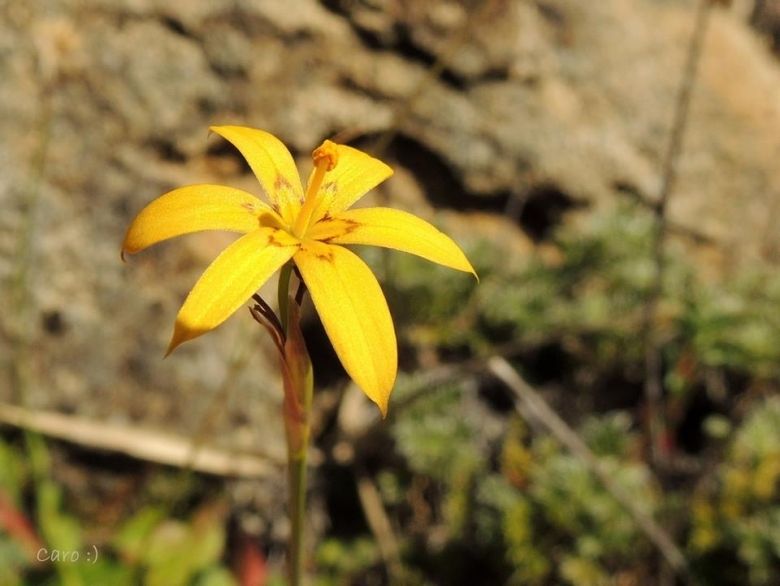Accepted Scientific Name: Sisyrinchium patagonicum Phil. ex Baker
Handb. Irid. 126. 1892 [Aug-Nov 1892] Baker

Bermudiana patagonica (Sisyrinchium patagonicum) Photo by: Carolina González
Origin and Habitat: Tierra del Fuego area north to the Rio Negro in Argentina and in Patagonia in south Chile.
Habitat and ecology: Sisyrinchium patagonicumSN|31146]]SN|31146]] can be found in low and high altitude, andean interior valleys in rocky meadows, low scrub and sandy beaches. It grows in humid areas usually where the soil dries out later in the season.
Synonyms:
See all synonyms of Sisyrinchium patagonicum
back
Accepted name in llifle Database:Sisyrinchium patagonicum Phil. ex BakerHandb. Irid. 126. 1892 [Aug-Nov 1892]Synonymy: 6
back
Common Names include:
SPANISH (Español): Lirio silvestre
Description: Sisyrinchium patagonicumSN|31146]]SN|31146]] is a delicate herbaceous perennial herb, 10 to 30(-40) cm tall, with narrow green leaves forming a grassy clump from which bloom single stems of small, but very pretty star-shaped yellow flowers.
Leaves: Very slender, iris-like, shorter to longer, l-4mm wide, often more or less glaucous produced in autumn or early spring, according to water supply and temperature.
Inflorescence: Stalk 10-30 cm or more in height, winged. Spathes two of about equal size.
Flowers: Delicate, 14-20 mm in diameter. Tepals reflexed often with thread-like tips, yellow with brown or purplish veining on the outside. The predominant colour of the flower is yellow with darker throat, sometimes up to an intense ocher-purple. The filaments are fused in a column surrounding the style. The filamental column had oil-producing trichomes densely arranged on the lower third part of the column.
Flowering: Late spring to summer.
Bibliography: Major references and further lectures
1) Múlgura, M.E. “Catálogo de las Plantas Vasculares de la República Argentina” Missouri Botanical Garden, St. Louis. 1996
2) Rodriguez Rios, R. “Die Chilenischen Arten der Gattung Sisyrinchium L. (Iridaceae).” Mitteilungen der Botanischen Staatssammlung München. München 1986
3) Innes, C. “The World of Iridaceae” Holly Gare International Ltd., Ashington. 1985
4) Marticorena, C. & Quezada, M. “Catálogo de la flora vascular de Chile. Gayana.” Botánica 1985
Cultivation and Propagation: Sisyrinchium patagonicumSN|31146]]SN|31146]] is an Alpine specie recommended for borders, to naturalize on a meadow, in the front of beds and borders, pots, containers, etc. Can be used as cut flower. It is certainly a beautifully delicate plant that merits cultivation..
Soil: Should grow it in a peat soil kept sufficiently moist, but adapts in any rich, well drained soil in full sun.
Water: Do not over water.
Exposure: Sun.
Hardiness: Fully hardy. The plant tolerates low temperatures (-8° C or less), can tolerate occasional snow cover for up to a couple of weeks per year. USDA Hardiness Zone V-VI.
Maintenance: Deadhead the flowers and only keep the seed pods you will require for further propagation of your sisyrinchiums. This will prevent the rhizome to age too soon.
Use: They make superb rock garden plants, as well as adequate for the front of a border as well as being perfect for pots and containers, where they will be more reliably perennial, multiplying up yearly.
Propagation: It may be propagated by offsets and probably by seeds. Sow them during autumn, in a mix of equal parts of compost, regular garden soil and sharp river sand. Cover this mix with a layer of sand, distribute the seeds and spread some more sand over them to barely cover the seeds. Place your sowing pan in a cold frame or cold greenhouse if you have heavy rain in your area. If you have snow, place the sowing pan outdoors and let nature do its work. The seedlings can be transplanted once they are 5cm tall. These pretty plants can bloom the first year grown from seeds, but will display their best from the second year on.









